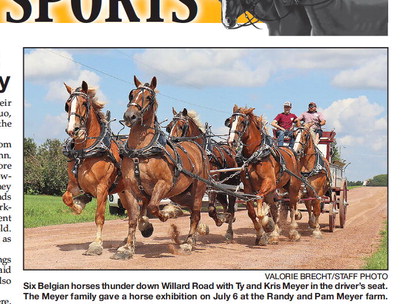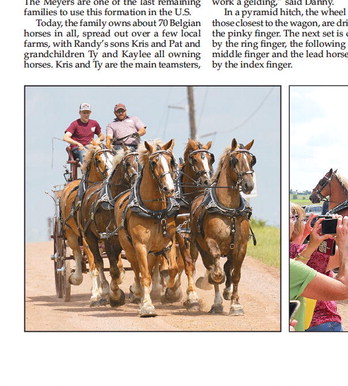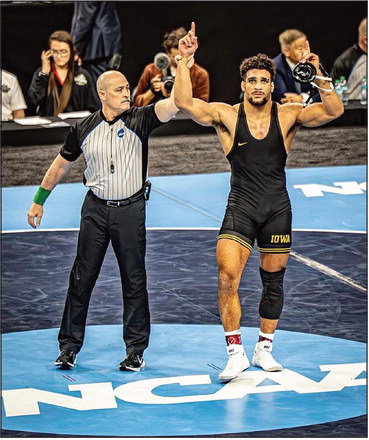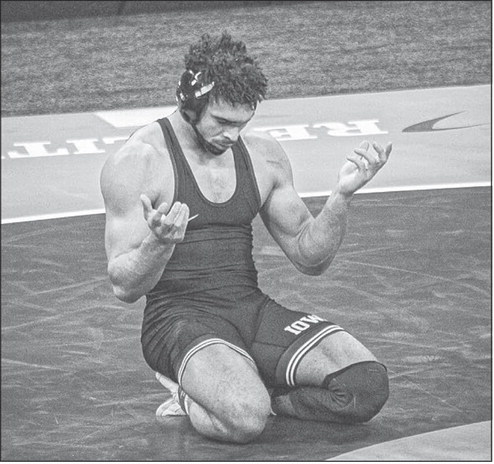Belgian draft horses captivate onlookers with powerful display


By Valorie Brecht With hooves the size of dinner plates and weighing in at 2,000 to 2,200 pounds, Belgian draft horses inspire the awe and curiosity of onlookers. Providing a means for people to view these majestic beasts is part of what keeps one local family competing and exhibiting them year after year.
The Meyer family held their first-ever open house this past Saturday at the Randy and Pam Meyer farm about a mile outside of Loyal, for people to view and learn about the Belgian horses. The animals were hitched up in a six-horse hitch, with three rows of two horses.
The Meyers could no doubt be considered “horse people,” having raised and bred draft horses for many years.
“It’s something they all inherited, my one bad habit,” said Randy with a grin.
Randy’s father Alfred (1915-1996) farmed with the help of workhorses and also had his horses compete in pulls. He was a member of the Wisconsin Horse Pullers Association and coordinated the Loyal Corn Fest Horse Pull.
Randy is the one who first got the horses hooked up in the pyramid hitch, after seeing it at the Marshfield fair in the late 1990s and wanting to try it himself. The formation involves 10 horses hooked up in a “bowling pin” layout, with a row of four horses, then three, then two and finally one at the front. The Meyers are one of the last remaining families to use this formation in the U.S.
Today, the family owns about 70 Belgian horses in all, spread out over a few local farms, with Randy’s sons Kris and Pat and grandchildren Ty and Kaylee all owning horses. Kris and Ty are the main teamsters, sometimes driving the horses on their own and sometimes as a father-son duo, especially for larger formations like the pyramid hitch.
Many of the Meyers’ horses come from Brockwood Belgians out of Dayton, Penn. Geldings need to be 3 or 4 years old before they join the hitch. They will keep growing until they’re about 8 years old. They eat about one bale of hay and 20 pounds of grain every day, when they are working. The horses on the Meyers’ current team range in age from 4 to 13 years old. However, they have had horses as old as 18 on the team.
The teams are made up of all geldings because they are easier to work with, said Danny Meyer, Randy’s brother who also owns horses.
“There’s a lot of mare hitches out there, probably more than geldings, but those of you that have worked around the two of them, there’s a reason. The big thing is, of course, the heat periods of the mares and you have to put up with that once in a while. If you’ve got them bred, well then you’ve gotta be careful that you don’t overdo them. A lot of the guys that show mares, they’re foaling mares already in February. And then they try to get them weaned in three months and get the mares back in shape by the time July comes around so they can show. But it’s for extra income, but it’s a lot easier if you work a gelding,” said Danny.
In a pyramid hitch, the wheel horses, or those closest to the wagon, are driven using the pinky finger. The next set is controlled by the ring finger, the following set by the middle finger and the lead horse is driven by the index finger.
“The important thing is to keep the lines straight. The horses only know what they feel in their mouth,” said Randy.
Each group of horses has a distinct role to play on the team. Typically the wheel horses should be the biggest, strongest horses. The wheel horses in Saturday’s hitch were 19 hands tall, or 6 feet, 4 inches, as measured from the withers, the highest point where the neck meets the back, to the ground. In contrast, the lead horses were only about 17.2 hands tall (5 feet, 10 inches).
“Remember that the wheel horses are the only ones that pull the wagon. They’re the only ones that back the wagon. They’re the ones with the straps on the batch and the breeching on the back so they can back up. The other horses don’t have the breeching,” Danny explained.
He said the middle horses are there to assist, but should not be doing the brunt of the work. If a judges sees them pulling too much, the team will get knocked down in points.
The lead horse or horses should be athletic and alert, with a showy quality to them.
“The key to a real good show team is the lead horses. They always say the judge watches the horses come in the ring the first round, and he’s pretty well got his mind made up the way they come in the ring. The lead horses gotta catch your eye. A good lead horse is hard to find.
“When you drive them, the lead horses’ tugs will be loose. Only when he stretches them out. But going around in a circle, we
Please see Horses, page 13
VALORIE BRECHT/STAFF PHOTO
STACY TIERMAN PHOTOGRAPHY AND VALORIE BRECHT/STAFF PHOTO








